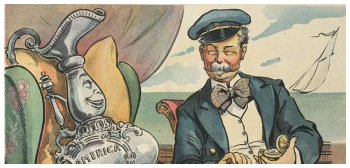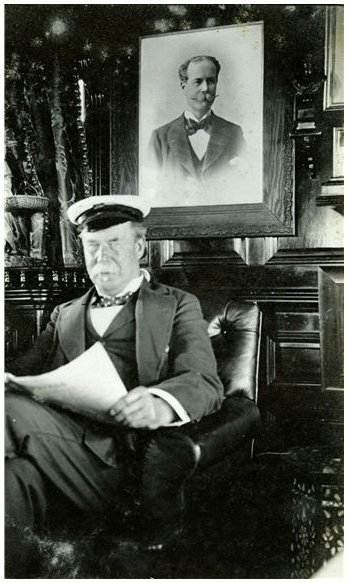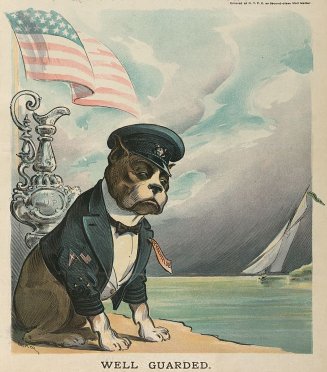Yves GARY Hits: 4941
Category: 1920 : CHALLENGE N°13
 EVENTS LEADING UP TO THE RACE OF 1914.
EVENTS LEADING UP TO THE RACE OF 1914.After the race of 1903 and Sir Thomas Lipton's third failure to "lift" the Cup, ten years passed before a challenge that was satisfactory to the N.Y.Y.C. was accepted and terms agreed upon for a race in the year 1914. This was the longest period of inactivity in America's Cup racing since the first race in this country in 1870.
During all these years not a single foreign yachtsman (save Lipton) came forward with even a prospective challenge, though there were rumors at various times that some English, Swedish, or German racing man was contemplating an assault on the Cup. Off and on during this period Sir Thomas was in communication with the New York Yacht Club, but nothing actually came of the letter writing until 1913, as will be duly told.
Several things were responsible for this lack of interest in the America's Cup. It had been apparent for some time that the trend of these Cup contests was greatly narrowing their scope, and restricting competition to those who could afford to spend a good sized fortune on a very slim chance of success. In the last contest Reliance marked the extreme limit that had been achieved in the development of the racing machine (and possibly also the limit of that particular type of boat and rig), and, in general racing, there had been already a swing in the other direction toward a saner and more healthy type of yacht.
 In 1903 the New York Yacht Club adopted a racing rule that sounded the death knell of the flat, light displacement, scow-like boats. This rule took into account displacement as well as length and sail area, and by putting a premium on the first named encouraged a sharper, fullerbodied hull instead of the flat abortions that had grown up under the old rule. At a conference of most of the leading yacht clubs and racing associations of the East, held in 1905, this rule was pretty generally adopted as the racing rule in force in this country; and, while it is generally called the “Universal Rule”, it is only used in this country, England and the other European yachting countries having adopted a rule intended to bring about the same desired results, and known as the “International Rule”. Under these two rules a very fine type of racing craft has been produced, — able, seaworthy, safe and yet fast. Boats built under the rules were of some use other than for mere racing, and had a value as cruisers even when their racing days were over.
In 1903 the New York Yacht Club adopted a racing rule that sounded the death knell of the flat, light displacement, scow-like boats. This rule took into account displacement as well as length and sail area, and by putting a premium on the first named encouraged a sharper, fullerbodied hull instead of the flat abortions that had grown up under the old rule. At a conference of most of the leading yacht clubs and racing associations of the East, held in 1905, this rule was pretty generally adopted as the racing rule in force in this country; and, while it is generally called the “Universal Rule”, it is only used in this country, England and the other European yachting countries having adopted a rule intended to bring about the same desired results, and known as the “International Rule”. Under these two rules a very fine type of racing craft has been produced, — able, seaworthy, safe and yet fast. Boats built under the rules were of some use other than for mere racing, and had a value as cruisers even when their racing days were over.
While the New York Yacht Club was racing in all of its regattas under this new rule of measurement and time allowance, it would never commit itself as to whether or not it would agree to race for the America's Cup under the same rule. As early as the winter of 1903, Sir Thomas sounded the Club on this point and definitely asked, on December 13th of that year, if the new rules just adopted would apply to the Cup races. The Club answered that that matter could only be decided when laid before the Club on receipt of a regular challenge; that the "mutual agreement" clause governed all rules of measurement, etc., and that if no agreement could be reached as to these points between the New York Yacht Club and the challenging club, then the latter had a right to sail three races without time allowance, as provided in the Deed, as long as the challenging boat measured between 85 and 90 feet on the water (if she was a sloop), in which event there would be, of course, no restrictions on form or sail area, and Reliance, or a boat of her type (which they were trying to get away from in ordinary racing) would still be eligible. Though this attitude was equivocal, in that it did not say positively that it would not agree to race under the new rules, the New York Yacht Club has persisted in it ever since.
Lipton, as well as most other yachtsmen abroad and at home, believed that we should get away from boats of the Reliance type; and with this point unsettled no unconditional challenge was received, though Sir Thomas actually sent a conditional challenge in 1907.
There also seemed to be some sentiment in the holding club that Lipton had been given enough chances to race for the Cup, and the members, at least those guiding the club's Cup policy, were loath to make any concessions, if they may be called that, to him. To put it in another way, they would have welcomed more heartily a challenge from another quarter.
 Yet it must be remembered that in 1899 they had welcomed the Irish baronet when he was not only unknown in the yacht racing world, but was not even a representative English sportsman. He challenged after the unpleasant Dunraven incident, at a time when the New York Yacht Club needed a challenge badly, and he raced in a sportsmanlike manner. In the intervening years, by consistent racing in home waters, he had become the foremost big-boat racing yachtsman in Great Britain, and as such was entitled to the consideration that was due a sportsman of that standing.
Yet it must be remembered that in 1899 they had welcomed the Irish baronet when he was not only unknown in the yacht racing world, but was not even a representative English sportsman. He challenged after the unpleasant Dunraven incident, at a time when the New York Yacht Club needed a challenge badly, and he raced in a sportsmanlike manner. In the intervening years, by consistent racing in home waters, he had become the foremost big-boat racing yachtsman in Great Britain, and as such was entitled to the consideration that was due a sportsman of that standing.
Late in 1912, no other challenger being in sight, Lipton opened negotiations again, and intimated his readiness to challenge if any assurance could be had of racing with a boat of a certain size, and under the new rules. The Club still refusing to commit itself, he finally sent a definite challenge, naming a boat of 75-feet water line length, and stipulating that the New York Yacht Club meet him with a boat of not over that length. This the Club refused to do, claiming for the sake of precedent, if nothing else, that it could not and would not waive its right to meet him with any sized boat it saw fit that was eligible under the Deed. After this, challenge was turned down. Sir Thomas withdrew his qualifications and sent, in April, 1913, through the Royal Ulster Yacht Club, an unconditional challenge.  The New York Yacht Club accepted this challenge, and in drawing up the conditions of the series by "mutual consent" agreed to race under the new measurement rules. It also decided to meet him with a 75-foot water line boat. Having maintained its position as to its “rights" in these matters the Club met Sir Thomas Lipton fairly on the points for which he had stood out.
The New York Yacht Club accepted this challenge, and in drawing up the conditions of the series by "mutual consent" agreed to race under the new measurement rules. It also decided to meet him with a 75-foot water line boat. Having maintained its position as to its “rights" in these matters the Club met Sir Thomas Lipton fairly on the points for which he had stood out.
Some of the correspondence on this point is interesting and is given here.
Copy of letter to the secretary of the Royal Ulster Yacht Club :
|
New York Yacht Club, New York, July 31, 1913. Dear Sir, — I have already acknowledged by cable the receipt of your cable of July 19 and your letter of July 19 confirming the same and enclosing a copy of the conditions recently forwarded to you, as amended in relation to increase of time limit from five and a half to six hours. I have been unable until now to make any other reply to these communications except the bare acknowledgment of their receipt, because of the difficulty of getting together the members of our committee, who are necessarily scattered in different places at this time of the year. I have, however, now submitted them to the committee and am instructed by them to reply as follows: You state that Sir Thomas Lipton has authorized your committee to sign unconditionally the agreement heretofore forwarded to you, but you say at the same time in substance that Sir Thomas Lipton assumes that it is not the intention of our club to build a ninety-foot vessel, and that while he understands and appreciates the grounds on which our club desires to keep alive the right to defend with a yacht of greater length than the challenger, he is convinced that this right will not be exercised by our club, and that it is in this firm belief that he has given you the authority referred to to sign the agreement. We regret that we feel it quite impossible for us to accept an agreement tendered to us under such circumstances. The agreement expressed in the conditions forwarded to you constitutes the mutual agreement referred to in the deed of gift which the challenging and the defending club are authorized to enter into. Such an agreement is the act of the two clubs and not of the person who happens to be the owner of the challenging or the defending vessel. If there is any one thing which we have endeavored to make plain in the correspondence which we have had the honor to conduct with you and in certain other negotiations which we have had with Sir Thomas Lipton in the past, it is that we could not accede to the proposition that the challenging club could in any manner, directly or indirectly, be conceded the right to determine the power or size of the defending vessel so long as she came within the extreme limits set forth in the deed of gift. You requested us to accept a challenge conditioned upon the defending vessel not to exceed seventy-five feet on the water line. This challenge, for the reasons given, we found ourselves obliged to decline. |
You then expressed your willingness to withdraw the condition if we would agree to an interpretation of the deed of gift which you suggested; that the mere fact of naming a seventy-five foot length for the challenger ipso-facto prescribed the same length as the limit for the defender. This we also found ourselves unable to accept. You then withdrew all stipulations as to the size of the yacht which should defend the Cup and forwarded a new challenge which contained no conditions upon this subject. After some correspondence concerning certain details of this last challenge we accepted with the stipulation that "such acceptance not to be effective until all the conditions governing the match shall have been agreed upon, reduced to writing and signed by both clubs, as on former occasions." (See our cables of May 17 and 19, the terms of which were accepted in your cable of May 21.) We then forwarded you the conditions governing the match, constituting the mutual agreement between the two clubs, for your approval and signature, the last article of which was as follows: "All the agreements and understandings between the two clubs are set forth in the foregoing enumeration of conditions,'* an article which was inserted because of the manifest importance of having all the conditions governing SO important an event clearly set forth and expressed and not exposed to the uncertainties of implication concerning which minds might differ. We do not quite understand where your last cable now leaves the matter. You say that you are authorized by Sir Thomas Lipton to sign unconditionally the agreement, one of the fundamental provisions of which states that it embraces the whole understanding of the parties and excludes all assumption or implication, and at the same time you tell us that Sir Thomas Lipton, in authorizing you to sign it, has done so upon the assumption and with the firm belief that this club will, as a matter of fact, meet the challenger with a vessel of equal length — or, in other words, upon the assumption and with the firm belief that this club will now accept that very limitation upon its freedom of action to which it has from the beginning declined to subject itself. We are naturally anxious to remove all possibility of misunderstanding between our two clubs as to the nature and terms of the match arranged, and to this end we feel ourselves compelled to say that we can accept the signed conditions which you have returned to us only with the distinct understanding, as therein stated, that as signed they embody “all the agreements and understandings between the two clubs.” I have the honor to be, dear sir, very faithfully, G. A. CORMACK. |
Copy of cablegram from the secretary of the Royal Ulster Yacht Club in response to the letter sent by Mr. Cormack :
|
Belfast, 12th August, 1913. Your letter of 3lst ult. received. We are sorry our cable of July 19 has given rise to misunderstanding. The conditions proposed by your club were accepted and signed by the Royal Ulster Yacht Club with a full appreciation of clause you now emphasize, namely, “all the agreements and understandings between the two clubs are set forth in the foregoing enumeration of conditions.” Garrett. |
So the long debated matter was finally settled and we are at last to see a race once more between boats of a sensible size and type-boats in harmony with the existing spirit of yacht development and racing, and ones that can be built and run without the necessity of any half-million dollar syndicates. They are to be boats that will be of use for something after America's Cup racing is over, and will not have to lie idle for eleven years, propped up on shore, only to be finally broken up by the junk-man, as was the last defender, Reliance. The conditions agreed upon call for a series of three races out of five, alternating windward and leeward and triangular of thirty miles in length, outside of Sandy Hook, with a time limit of six hours. The dates selected are September 10th, 12th, 15th, and on Thursdays, Saturdays, and Tuesdays thereafter (if necessary) until completed. |
